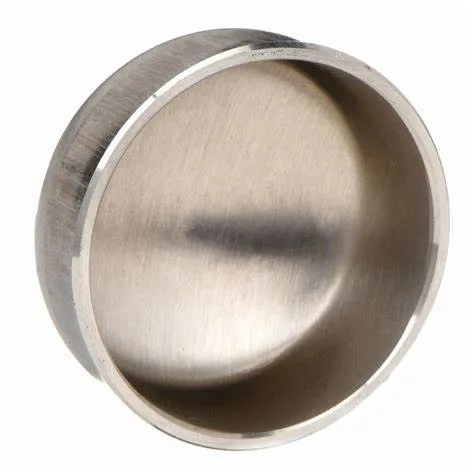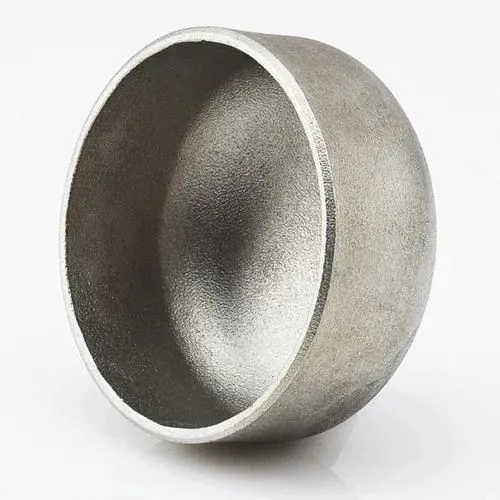JIS B2311 je japonski industrijski standard, ki zajema priključke za cevi za sočelno varjenje, vključno s pokrovi, ki se uporabljajo v cevovodnih sistemih. Pokrovčki za sočelno varjenje služijo zapiranju konca cevi in zagotavljajo tesnilo za preprečevanje puščanja ali kontaminacije. Tukaj je uvod v kapice za sočelno varjenje JIS B2311:
- 1. JIS B2311 Standard:
- - Standard JIS B2311 določa zahteve za načrtovanje, mere, materiale, proizvodnjo in preskušanje fitingov za sočelno varjenje, vključno s pokrovi, v cevovodnih sistemih.
- - Standard zagotavlja, da pokrovčki, proizvedeni v skladu s standardi JIS, izpolnjujejo standarde kakovosti in so združljivi z drugimi komponentami cevi.
- 2. Pokrov za sočelno varjenje:
- - Pokrov za sočelno varjenje, v skladu z JIS B2311, je nastavek, zasnovan za varno pokrivanje in tesnjenje konca cevi, ki nudi zaščito in ohranja celovitost cevnega sistema.
- - Pokrovčki se uporabljajo v situacijah, ko je treba konec cevi zapreti, trajno ali začasno, da se prepreči puščanje, kontaminacija ali zagotovi zaključek sistema.
- 3. Material in konstrukcija:
- - Pokrovi za sočelno varjenje po specifikacijah JIS B2311 so na voljo iz različnih materialov, kot so ogljikovo jeklo, nerjavno jeklo in legirano jeklo, da izpolnjujejo različne zahteve uporabe.
- - Ti pokrovi so izdelani po standardiziranih konstrukcijskih metodah, da se zagotovi močan spoj brez puščanja, ko so privarjeni na konec cevi.
- 4. Uporaba in prednosti:
- - Pokrovi za sočelno varjenje se uporabljajo v različnih panogah, vključno z nafto in plinom, kemičnimi procesi, čistilnimi napravami in še več, kjer je treba konce cevi varno zapreti.
- - Pokrovčki zagotavljajo zaščito koncev cevi pred okoljskimi elementi, preprečujejo kontaminacijo in pomagajo vzdrževati čistočo in celovitost cevnega sistema.
- 5. Namestitev in varjenje:
- - Pri namestitvi čelnih varjenih pokrovčkov so bistvenega pomena pravilne namestitvene prakse, vključno s pravilno poravnavo, pripravo konca cevi in tehnikami varjenja, da se zagotovi tesno tesnjenje, ki ne pušča.
- - Varjenje je običajna metoda za pritrjevanje pokrovčkov na cevi, ki zagotavlja varno in trajno zapiranje, ki lahko prenese pritisk, temperaturne spremembe in pretok tekočine v sistemu.
- Če povzamemo, pokrovi za sočelno varjenje JIS B2311 so ključne komponente, ki se uporabljajo v cevnih sistemih za varno tesnjenje in zaščito koncev cevi. Ti pokrovi ustrezajo standardiziranim zahtevam za zagotavljanje kakovosti, zanesljivosti in združljivosti v industrijskih aplikacijah, kjer sta potrebna zapiranje in zaščita cevi.
What Is a Butt Welding Cap and How Is It Used in Industrial Piping?
In industrial piping systems, end-of-line sealing and branch closures require robust solutions. A butt welding cap serves as a critical component for terminating pipes securely. By providing a seamless, welded closure, this fitting maintains system integrity, prevents leaks, and supports compliance with industry standards.
What Is a Butt Welding Cap?
A butt welding cap—also called a pipe end cap or buttweld end cap—is a round fitting designed to close off the end of a pipe. It’s manufactured to match the pipe’s outer diameter and schedule, with either a hemispherical or flat face. To install, both the pipe end and cap are beveled to form a V‑groove, enabling full‑penetration, fusion welds. Common materials include carbon steel, stainless steel, nickel alloys, and other engineered grades, chosen to satisfy pressure, temperature, and corrosion‑resistance requirements.
How Is Butt Welding Cap Used in Industrial Piping?
Butt welding caps find application across oil & gas, petrochemical, power generation, water treatment, and general process industries for both permanent and temporary closures. During hydrostatic testing, technicians install caps to seal off sections of piping while monitoring for leaks. In new construction or retrofit projects, caps terminate branch lines, future tie‑in spools, or dead‑end mains until system expansion. Welders prepare each joint by cleaning and beveling surfaces, aligning the cap precisely, and executing a root pass followed by filler passes per the qualified Welding Procedure Specification (WPS). Post‑weld heat treatment and non‑destructive examination (NDE)—such as radiography or ultrasonic testing—verify weld integrity and compliance with ASME B16.9 and related standards. Additionally, temporary caps enable safe isolation during maintenance, allowing for segment testing and dewatering under regulatory protocols.
Benefits and Best Practices
Butt welding caps offer a smooth‑bore transition that minimizes flow disruption and stress concentration. Their full‑penetration welds deliver exceptional structural strength and leak resistance. To optimize performance, engineers should:
Select caps with matching material grades and wall thicknesses
Adhere to proper bevel angles and joint fit‑up tolerances
Follow qualified WPS protocols rigorously
Consider cladding or protective coatings in corrosive environments to extend service life
Regular inspection and thorough documentation ensure long‑term reliability and safe operation under demanding conditions.
Butt welding caps are indispensable components for achieving durable, leak‑proof pipe terminations in a wide range of industrial applications.
Butt Welding Cap FAQs
What is a butt welding cap?
|
What materials are commonly used?
|
What standards govern butt welding caps?
|
How are butt welding caps installed?
|
Where are butt welding caps typically used?
|
What are the advantages of threaded caps?
|
















